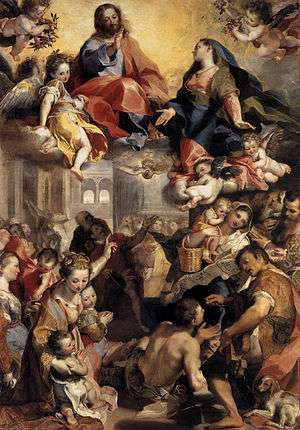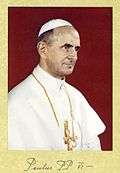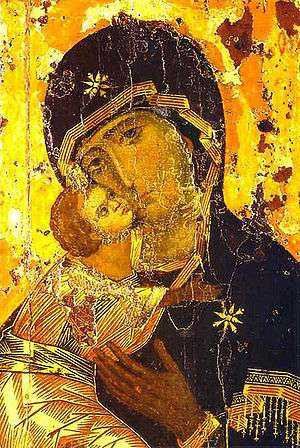Mother of the Church

In Roman Catholic Mariology, Mother of the Church (in Latin Mater Ecclesiae) is a title, officially given to Mary during the Second Vatican Council by Pope Paul VI.[1] The title was first used in the 4th century by Saint Ambrose of Milan, as rediscovered by Hugo Rahner.[1][2]
The title "Mother of the Church" was used by Pope Benedict XIV in 1748[3] and then by Pope Leo XIII in 1885.[4] The title was also used by Pope John Paul II[5] and is also found in the Catechism of the Catholic Church.[6]
Pope John Paul II stated that overall the title indicates the Blessed Virgin Mary's maternity of Christ's faithful, as deriving from her maternity of Christ in that "Mary is present in the Church as the Mother of Christ, and at the same time as that Mother whom Christ, in the mystery of the Redemption, gave to humanity in the person of the Apostle John [cf. John 19:27]. Thus, in her new motherhood in the Spirit, Mary embraces each and every one in the Church, and embraces each and every one through the Church."[7]
St. Ambrose and Hugo Rahner
The Church has traditionally portrayed the Blessed Virgin Mary together with the apostles and disciples gathered at that first Pentecost, joined in prayer with the first members of the Church. The title, Mater Ecclesiae is found in the writings of Berengaud, bishop of Treves (d. 1125).[8] In the 1895 encyclical Adjutricem populi (Helper of the People) Pope Leo XIII wrote, "She is invoked as Mother of the Church and the teacher and Queen of the Apostles". Following the title's usage by Leo XIII, it was later used many times in the teachings of John XXIII and Paul VI,[9] John Paul II and Benedict XVI.
The use of the Mater Ecclesiae title to the Virgin Mary goes back to Ambrose of Milan in the 4th century, but this was not known until its 1944 rediscovery by Hugo Rahner.[1][2] Rahner's Mariology, following Ambrose, sees Mary in her role within the Church. His interpretation, based solely on Ambrose and the early Fathers,[2] greatly influenced Vatican II[10] and Pope Paul VI,[11] who, quoting Ambrose, declared Mary the "mother of the Church".
Pope Paul VI

The Mother of the Church, carries on in heaven her maternal role with regard to the members of Christ, cooperating in the birth and development of divine life in the souls of the redeemed. - Pope Paul VI's "Credo of the People of God".[12][13]
Pope Paul VI pronounced the title at the closing of the third phase of the council.[14] A former archbishop of Milan, Paul VI used similar language to that of Saint Ambrose of Milan, calling Mary Model of the Church in light of her faith, love and complete unity with Christ and Mother of the Church because she gave birth to Christ.[15]
Paul VI made the pronouncement of the title Mother of the Church during his speech upon the closing of the third session of the Second Vatican Council on November 21, 1964: "For the glory of the Virgin and our consolation, we proclaim Mary the Most Holy Mother of the Church, that is, the Mother of the whole People of God, both the faithful and the pastors."[11]
In Redemptoris Mater Pope John Paul II referred to Paul VI's "Credo of the People of God" as a reaffirmation of the statement that Mary is the "mother of the entire Christian people, both faithful and pastors" and wrote that the Credo "restated this truth in an even more forceful way":[12]
Pope Benedict XVI also referred to the Credo of Paul VI and stated that it sums up all of the scriptural texts that relate to the matter.[13]
Pope John Paul II
Following the 1981 assassination attempt on his life, Pope John Paul II ordered the installation of a mosaic of Mary, Mother of the Church on a building overlooking St. Peter's Square, partially as tribute to her intercession in saving his life. In 1987, he repeated this title Mother of the Church in his encyclical Redemptoris Mater and at a general audience on September 17, 1997.[16]
With regard to the title "Mother of the Church", John Paul used Redemptoris Mater as an opportunity to explain how the Blessed Virgin Mary's maternity of Christ's faithful derives from her maternity of Christ, as well as how Mary serves as a "type", or model, of the Church as a whole.
- Mary is present in the Church as the Mother of Christ, and at the same time as that Mother whom Christ, in the mystery of the Redemption, gave to humanity in the person of the Apostle John. Thus, in her new motherhood in the Spirit, Mary embraces each and every one in the Church, and embraces each and every one through the Church. In this sense Mary, Mother of the Church, is also the Church's model. Indeed, as Paul VI hopes and asks, the Church must draw "from the Virgin Mother of God the most authentic form of perfect imitation of Christ."[17]
On September 17, 1997, St. Pope John Paul II devoted a Wednesday general audience to the title "Mother of the Church" with regard to its application to the Blessed Virgin Mary.
- The faithful first called upon Mary with the title "Mother of God", "Mother of the faithful" or "our Mother", to emphasize her personal relationship with each of her children. Later, because of the greater attention paid to the mystery of the Church and to Mary’s relationship to her, the Blessed Virgin began more frequently to be invoked as "Mother of the Church"."[18]
- The title "Mother of the Church" thus reflects the deep conviction of the Christian faithful, who see in Mary not only the mother of the person of Christ, but also of the faithful.[19]
Pope Benedict XVI
Pope Benedict XVI addresses the issue, why Roman Catholic Mariology is related to ecclesiology, the teaching about the Church. On first sight, he argues, it may seem accidental, that the Council moved Mariology into ecclesiology. This relation helps to understand what "Church" really is. The theologian Hugo Rahner showed that Mariology was originally ecclesiology. The Church is like Mary.[20]
The Church is virgin and mother, she is immaculate and carries the burdens of history. She suffers and she is assumed into heaven. Slowly she learns, that Mary is her mirror, that she is a person in Mary. Mary on the other hand is not an isolated individual, who rests in herself. She is carrying the mystery of the Church.[20]
See also
| Wikimedia Commons has media related to Mater Ecclesiae. |
Notes
- 1 2 3 International Theological Commission, Vol II: 1986-2007 edited by Michael Sharkey and Thomas Weinandy (Aug 21, 2009) ISBN 1586172263 page 208
- 1 2 3 Hugo Rahner, "Mater Ecclesia - Lobpreis der Kirche aus dem ersten Jahrtausend", Einsiedeln/Köln 1944
- ↑ Bullarium Romanum,series 2, t. 2, n. 61, p. 428
- ↑ Acta Leonis XIII, 15, 302
- ↑ Redemptoris Mater Redemptoris Mather item 47 at the Vatican website
- ↑ "Mary, Mother of Christ, Mother of the Church." Catechism item 963 at the Vatican web site
- ↑ Pope John Paul II, Encyclical Redemptoris Mater Redemeptoris Mater item 47 at the Vatican web site
- ↑ Mauriello, Matthew R., "Mary, Mother of the Church", Fairfield County Catholic, January 1996
- ↑ Pope John Paul II General Audience. September 17, 1997. "The Blessed Virgin is Mother of the Church", no. 2
- ↑ Lumen Gentium Chapter eight,
- 1 2 CONCLUSIONE DELLA III SESSIONE DEL CONCILIO VATICANO II ALLOCUZIONE DEL SANTO PADRE PAOLO VI, paragraph no. 30
- 1 2 John Paul II, Redemptoris Mater, no. 47, citing Pope Paul VI, Solemn Profession of Faith (30 June 1968), 15: Acta Apostolicae Sedis 60 (1968) 438f.
- 1 2 Mary: The Church at the Source by Benedict XVI, Adrian Walker and Hans Urs Von Balthasar (Oct 1, 2005) ISBN 158617018X pages 58-59
- ↑ Leo Cardinal Scheffczyk, Vaticanum II, in Remigius Bäumer, Leo Scheffczyk (Hrsg.) Marienlexikon Gesamtausgabe, Institutum Marianum Regensburg, 1994, page 568
- ↑ Ambrose of Milan, De inst. Virg 98, PL 16, 328 and IV, 3,4,PL17,876
- ↑ Blessed Virgin Is Mother Of The Church
- ↑ Redemptoris Mater, no. 47, citing Pope Paul VI, Discourse of 21 November 1964: AAS 56 (1964) 1016
- ↑ John Paul II. General Audience. September 17, 1997. "Blessed Virgin is Mother of the Church," no. 2
- ↑ John Paul II. General Audience. September 17, 1997. "The Blessed Virgin is Mother of the Church," no. 5
- 1 2 Joseph Kardinal Ratzinger: Weggemeinschaft des Glaubens. Kirche als Communio. Festgabe zum 75. Geburtstag, hg. vom Schülerkreis, Augsburg 2002)

